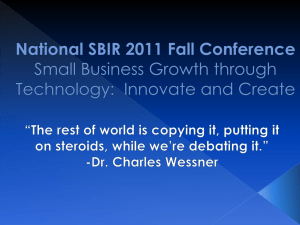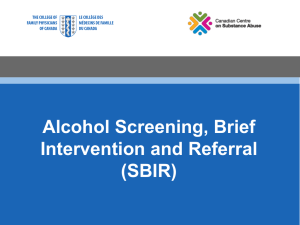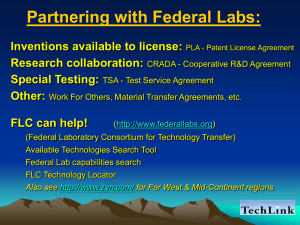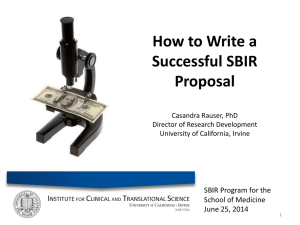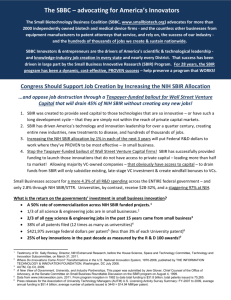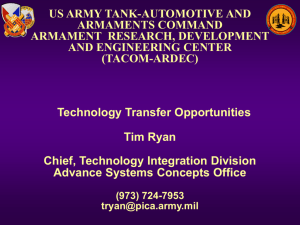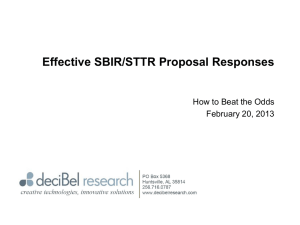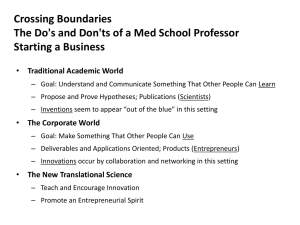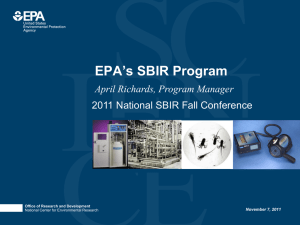Tim Wittig, Principal, Technology Management Advisors, Science
advertisement
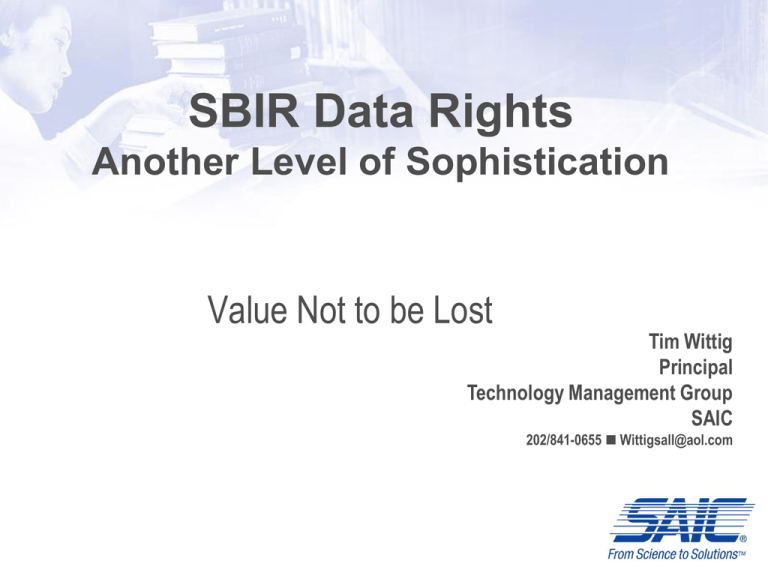
SBIR Data Rights Another Level of Sophistication Value Not to be Lost Tim Wittig Principal Technology Management Group SAIC 202/841-0655 n Wittigsall@aol.com Data Rights – A Part of the IP Package • The IP Package – Patents - 35 USC 202 Etc. and Bayh Dole Act – Copyright – 17 USC 105 – Government Works Not Eligible – Data Rights – Contract, SBIR, TSA and CRADA Rules – Trade Secret – State Statute Driven What is “Data” in Federal Contracting • Data is Anything First Fixed During the Contract or CRADA is Data Unless otherwise Defined • An Invention is a Special Kind of Data • Here not concerned with administrative or financial info • Data Generally Belongs to the Contractor (Partner) With Government Use Rights Attached • What Are Government Use Rights – Rights in Data Will Be Changed By Contract Language and Facts – Data Rights Vary From Unlimited Gov. Rights to Restricted Rights • Most restrictions are driven by inclusion of prior created data – Only Gov. Paid Material, Some Private Input, All Private Input. – CRADA and SBIR Data Rights Allow for a 5 Years Proprietary Period where no “public disclosure” should be made • Special Works Exception Making Sense of Data Rights • Data created during a Government Contract can be very valuable. – Beyond patent data, Technical Data could be the key to special processes, material, and design yield a unique and valuable product or service. – Often, companies will avoid patenting to protect vital data, avoiding costs long delays in legal proceedings, and litigation risks. • However, this is a very complex area as the Government cannot make up its mind. Special rules for – Marking of SBIR and Proprietary material, Copyright – Data from CRADA and Test Service Agreements • So, what are these “Rights”? PARSING RIGHTS – NONCOMMERCIAL COMPUTER SOFTWARE (CS) AND TECHNICAL DATA (TD) Rights Category Unlimited Rights Category Criteria Permitted Uses Internal to Government Development exclusively at Government expense; also, Form, Fit & Function; Installation, Operation, Maintenance & Training. Permitted Uses outside Government Unlimited; no restrictions Government Purpose Rights Development with mixed funding Unlimited; no restrictions Only for “Gov’t purpose”; no commercial use Limited Rights (applies to TD only) Development exclusively at private expense Unlimited; except may not be used for manufacture by others Emergency repair/overhaul; evaluation by foreign gov’t Restricted Rights (applies to CS only) Development exclusively at private expense Only one computer at a time; minimum backup copies; modification forbidden Emergency repair/overhaul; certain services and maintenance Prior Government Rights Whenever Government has previously acquired rights in the deliverable TD/CS Specifically Negotiated License Rights Mutual agreement of the parties – nonstandard situations Same as under the previous contract As negotiated by the parties; however, must not be less than limited rights in tech data, and must not be 5 in computer software less than restricted rights Now, what are the Regular SBIR Data Rules • Data created under and SBIR phase I or II belongs to the Small Business but the Gov. may use it royalty free. • However, the Gov. may not disclose to the public or its Contractors – Not like usual Government Use Rights language – But can disclose to support contractors who sign NDAs. • Driven by statutes created in the 70 and 80s – the 2011 Defense Authorization Act expanded and strengthened SBIR Data Rights • Data rules created in the new implementing instructions cannot be bargained away as the price of getting an SBIR Award SBIR Data Rights Rules - 2 • Gov. use of SBIR data is limited to use only by the Gov. and its support contractor (not like usual data) • SB may request that SBIR Data be withheld from the public for 5 years (4 years for non-DoD agencies). • SB can request continuation of withholding of SBIR Data as long as SBIR company is involved in furtherance of efforts of previous SBIR funded activity. – Includes other Gov. contracts but not commercial efforts maybe • Different from “Proprietary Rights” in data that is brought to the contract effort by the SB. (later) What businesses are eligible? • Small at the time of the award – 500 or less employees • Different from the Usual Size Standard Rules • SBA Affiliation Rules – Ownership – at least 51 percent control by individuals who do not own or control other companies such that the affiliations of these companies yields an entity larger than the SBA size standard. • SBIR Rules – More than 50% owned by US Citizens or Resident Aliens – Less than 49% owned by a hedge fund, venture capital operating company or a private equity fund. • What about a SBIC or MeSBIC? “Proprietary” Data • Here we begin another confusing arena where failure to act will causes loss of ownership in intellectual property! • What is “Proprietary Data” – Generally – data created at private expense by the SB that is: • Not available to the public without restriction • Not previously disclosed to the government • Not independently created by the government • This is information the SBIR company brings to the effort. • SB must: – Mark it as “proprietary” on every page, providing name of owner – Identify the data and describe basis for claim • Once disclosed to the Gov., it is always disclosed! There is a Ritual Here • You must use specific words to mark SBIR data! • Use – DEFARS 252.227.7018 for Defense Agency contracts – FAR 52.227.20 for non-defense agencies • Use the exact wording • Also use Williams Company Proprietary on every page where proprietary info appears (paragraph markings) • You can cure by sending in remedial marking chart but any disclosure before receipt is IP lost. So What??? • Data can be as valuable as a patent – Know-how, processes, materials, etc. • Unpatented properly marked data used to give you a competitive edge in contract competition can subsequently be withheld from disclosure for 5 years without the cost of patenting. Likewise, SBIR data can also be withheld from your competitors for 5 years • Careful planning your IP protection program will allow you to reduce costs while maintaining a competitive edge and containing the ever increasing cost of patenting and the every unpredictable outcome of litigation. • Don’t give the competitive edge to your competitor. Questions???? Tim Wittig Principal SAIC Technology Management Advisors Wittigr@saic.com Wittigsall@aol.com 202 841 0655
